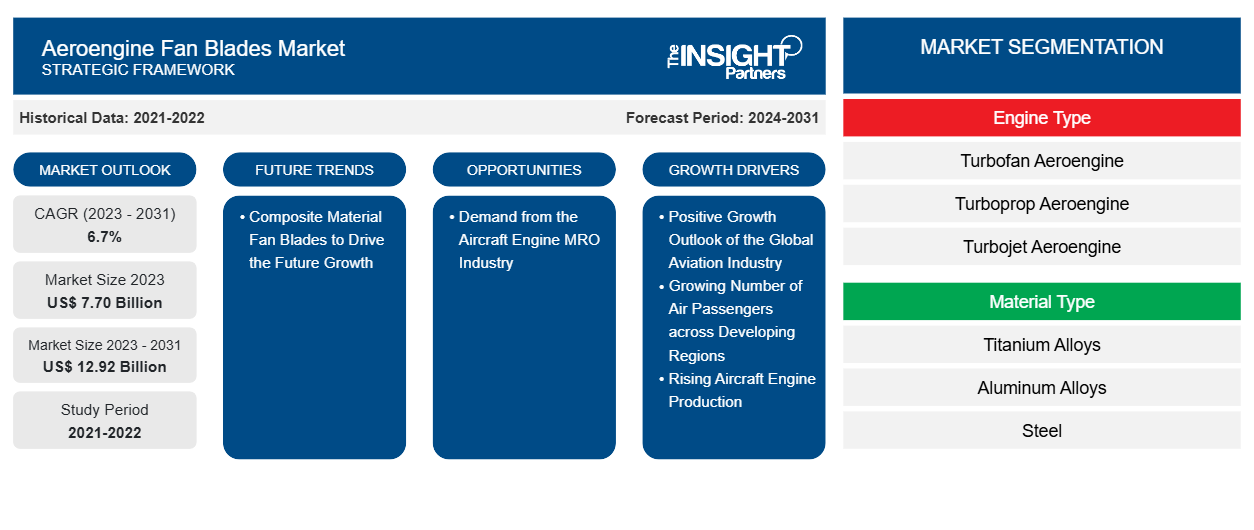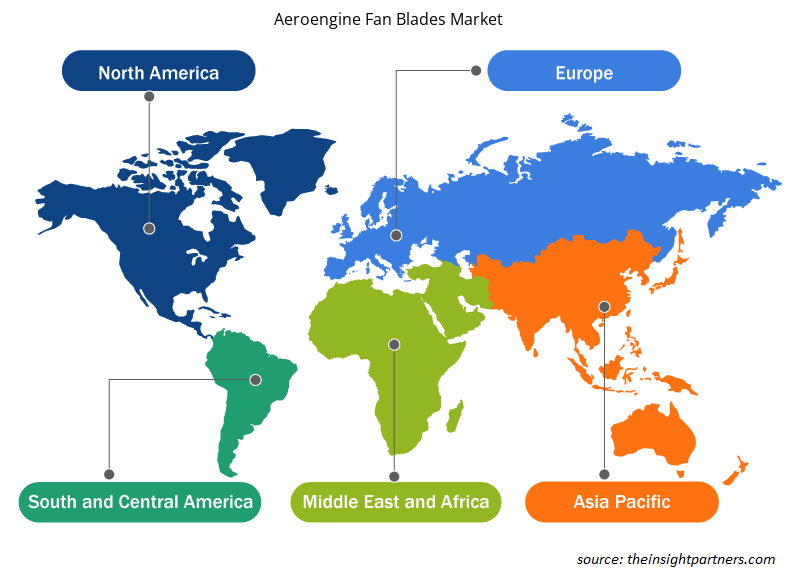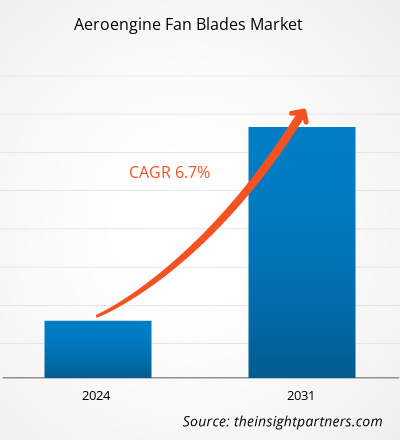Si prevede che le dimensioni del mercato delle pale dei ventilatori per motori aeronautici raggiungeranno i 12,92 miliardi di dollari entro il 2031, rispetto ai 7,70 miliardi di dollari del 2023. Si prevede che il mercato registrerà un CAGR del 6,7% nel 2023-2031. La crescita del mercato e la domanda di pale dei ventilatori per motori aeronautici in vari paesi dipendono dalla presenza di operatori della produzione di aeromobili, produttori di motori aeronautici, produttori di componenti aeronautici e fornitori di servizi di manutenzione, riparazione e revisione. Alcuni dei paesi chiave che si prevede guideranno la domanda di pale dei ventilatori per motori aeronautici nei prossimi anni includono Stati Uniti, Regno Unito, Francia, Germania, Russia, Cina, Giappone, Brasile, India e Turchia, tra gli altri.
Analisi di mercato delle pale dei ventilatori per motori aeronautici
Di seguito sono riportati alcuni dei punti chiave menzionati da alcuni dei principali opinion leader che operano nel mercato delle pale dei ventilatori per motori aeronautici :
- I fattori chiave che influenzano la crescita del settore dell'aviazione globale includono la domanda di viaggi aerei, i cambiamenti normativi, gli sviluppi infrastrutturali e i progressi tecnologici.
- La domanda di viaggi low cost sta aumentando a un ritmo impressionante in tutte le aree geografiche. Si prevede che la crescente popolarità e domanda di velivoli commerciali LCC e ULCC offrirà ampie opportunità di crescita futura per le aziende di pale di ventole per motori aeronautici in tutto il mondo.
- Si prevede che l'adozione di materiali compositi da parte di importanti produttori di pale per ventilatori quali GE Aviation, CFM International e Rolls-Royce Plc, unita alle attività di ricerca e sviluppo in corso per migliorare le prestazioni di vari materiali compositi, darà impulso alla crescita delle pale per ventilatori in composito nel prossimo futuro.
Panoramica del mercato delle pale dei ventilatori per motori aeronautici
L'ecosistema del mercato delle pale dei ventilatori per motori aeronautici comprende le parti interessate sopra menzionate. Tali parti interessate includono fornitori di componenti/hardware; produttori di pale dei ventilatori per motori aeronautici; aziende di manutenzione, riparazione e revisione (MRO); produttori di motori aeronautici e utenti finali. I produttori si procurano costantemente materie prime dai fornitori per produrre pale dei ventilatori con l'obiettivo di soddisfare le crescenti richieste dei clienti. Le materie prime utilizzate nella produzione di pale dei ventilatori includono titanio , fibra di carbonio e alluminio, tra gli altri. Dopo essersi procurati le materie prime, gli OEM di pale dei ventilatori per motori aeronautici producono pale dei ventilatori ad alte prestazioni e durata, soddisfacendo così le rispettive richieste dei clienti. Le pale dei ventilatori per motori aeronautici e i produttori di motori includono aziende come CFM International, GE Aviation e Pratt & Whitney che si procurano componenti da fornitori di componenti/hardware e producono pale dei ventilatori da utilizzare nei propri motori e li forniscono anche ad altri produttori di motori aeronautici e MRO. Gli utenti finali includono sia aerei commerciali che militari. Le MRO aeronautiche come AAR Corporation e Lufthansa Technik forniscono servizi di manutenzione, riparazione e revisione a questi utenti finali fornendo servizi di riparazione delle pale dei ventilatori. Con il crescente tasso di produzione di aerei commerciali e militari, si prevede che la domanda e gli ordini di sostituzione delle pale dei ventilatori aumenteranno a un ritmo costante nel periodo di previsione.aeroengine fan blade market ecosystem comprises of the above-mentioned stakeholders. These stakeholders include hardware/component suppliers; aeroengine fan blades manufacturers; maintenance, repair & overhaul (MRO) companies; aircraft engine manufacturers, and end users. The manufacturers constantly procure raw material from the suppliers in order to manufacture fan blades with an objective to meet the growing demands of the customers. The raw materials used in the production of fan blades include aeroengine fan blades OEMs manufacture fan blades with high-performance and durability, thereby, meeting respective customer demands. Aeroengine fan blades as well as engine manufacturers include companies such as CFM International, GE Aviation, and Pratt & Whitney procure components from hardware/component providers and manufacture fan blades to use in their own engines as well supply them to other aircraft engine manufacturers and MROs. The end users include both commercial and military aircrafts. Aircraft MROs such as AAR Corporation and Lufthansa Technik provide maintenance, repair & overhaul services to these end users by providing fan blade repairing services. With the growing production rate of commercial and military aircrafts, the demand and replacement orders for fan blades is expected to increase at a steady rate over the forecast period.
Personalizza questo report in base alle tue esigenze
Riceverai la personalizzazione gratuita di qualsiasi report, comprese parti di questo report, o analisi a livello nazionale, pacchetto dati Excel, oltre a usufruire di grandi offerte e sconti per start-up e università
Mercato delle pale dei ventilatori per motori aeronautici: Fan Blades Market: approfondimenti strategici

-
Scopri le principali tendenze di mercato in questo rapporto.Questo campione GRATUITO includerà analisi di dati che spaziano dalle tendenze di mercato alle stime e alle previsioni.
Driver e opportunità di mercato per le pale dei ventilatori dei motori aeronautici Fan Blades Market Drivers and Opportunities
Aumento della produzione di motori aeronautici
La crescente produzione di motori aeronautici da parte dei principali produttori di motori sta spingendo la necessità di componenti per motori aeronautici, tra cui pale di ventole in diverse regioni. Ciò è ulteriormente spinto dalla domanda generata per la nuova produzione di aeromobili e dalle consegne future previste di oltre 40.000 aeromobili commerciali entro la fine del 2042 (secondo le previsioni di Boeing e Airbus). Inoltre, la necessità di nuove pale di ventole per motori aeronautici è ulteriormente spinta dalle crescenti consegne di motori a leap e motori turbofan da parte dei principali produttori di motori. Ad esempio, nel 2023, GE Aviation ha consegnato circa 1.570 motori a leap a diversi clienti in tutto il mondo. Inoltre, GE Aviation ha anche mirato a consegnare circa 1.884-1.963 motori turbofan nel 2024, oltre a generare una capacità di consegna di circa oltre 2.000 motori a leap all'anno entro il 2025. Tali fattori hanno spinto la crescita delle pale di ventole per motori aeronautici in diverse regioni in tutto il mondo.aeroengine components including fan blades across different regions. This is further propelled by the demand generated for new aircraft production and expected future deliveries of more than 40,000 commercial aircraft by the end of 2042 (According to the Boeing and Airbus forecasts). Further, the need for new aeroengine fan blades is further, propelled by the rising deliveries of leap engines and turbofan engines by major engine manufacturers. For instance, in 2023, GE Aviation delivered around 1,570 leap engines to different customers worldwide. Further, GE Aviation has also aimed to deliver around 1,884-1,963 of the turbofan engines in 2024 along with generating a capacity to deliver around more than 2,000 leap engines annually by 2025. Such factors have been pushing the growth for aeroengine fan blades across different regions worldwide.
Domanda dal settore MRO dei motori aeronautici
Il crescente numero di flotte di aeromobili in tutto il mondo è uno dei principali fattori che generano la necessità di operazioni di MRO dei motori. Inoltre, la MRO dei motori è il segmento più grande dell'intero settore della MRO degli aeromobili che spinge ulteriormente la domanda di componenti MRO dei motori aeronautici e del mercato delle pale dei ventilatori in tutto il mondo. Diverse compagnie aeree hanno preso iniziative per aggiornare le rispettive flotte di aeromobili in diverse regioni, il che sta ulteriormente stimolando la domanda di installazione di nuovi motori aeronautici. Ciò sta ulteriormente generando la necessità di installazione di pale dei ventilatori per motori aeronautici in tutto il mondo. Ad esempio, a gennaio 2023, GE Aerospace e Cargolux hanno annunciato di aver stipulato un accordo di supporto a lungo termine per il GE9X che alimenta la nuova flotta di aerei cargo Boeing 777-8 di Cargolux. L'accordo include un accordo di servizio pluriennale GE TrueChoice e l'ordine di due motori di riserva.
Analisi della segmentazione del rapporto di mercato delle pale dei ventilatori per motori aeronautici
I segmenti chiave che hanno contribuito alla derivazione dell'analisi di mercato delle pale dei ventilatori per motori aeronautici sono il tipo di motore, il tipo di materiale e la geografia.
- In base al tipo di motore, il mercato delle pale dei ventilatori per motori aeronautici è stato categorizzato in motori aeronautici turbofan, motori aeronautici turboprop e motori aeronautici turbojet. Il segmento dei motori aeronautici turbofan ha detenuto una quota di mercato maggiore nel 2023.
- In base al tipo di materiale, il mercato delle pale dei ventilatori per motori aeronautici è stato segmentato in leghe di titanio, leghe di alluminio, acciaio e compositi. Il segmento delle leghe di titanio ha detenuto la quota maggiore del mercato nel 2023.
Analisi della quota di mercato delle pale dei ventilatori per motori aeronautici per area geografica
L'ambito geografico del rapporto sul mercato delle pale dei ventilatori per motori aeronautici è suddiviso principalmente in cinque regioni: Nord America, Europa, Asia Pacifico, Medio Oriente e Africa e Sud America.
Il Nord America ha dominato il mercato delle pale dei ventilatori per motori aeronautici nel 2023, mentre la regione Asia-Pacifico probabilmente assisterà a una crescita significativa durante il periodo di previsione. Inoltre, la domanda di pale dei ventilatori per motori aeronautici in Nord America sta crescendo notevolmente a causa della presenza di un gran numero di produttori di motori aeronautici come General Electric, Pratt & Whitney, Williams International, Honeywell International Inc e CFM International. Queste aziende generano costantemente la domanda di componenti per motori aeronautici, comprese le pale dei ventilatori nella regione del Nord America per applicazioni di motori aeronautici.
Approfondimenti regionali sul mercato delle pale dei ventilatori per motori aeronautici
Le tendenze regionali e i fattori che influenzano il mercato delle pale dei ventilatori per motori aeronautici durante il periodo di previsione sono stati ampiamente spiegati dagli analisti di Insight Partners. Questa sezione discute anche i segmenti e la geografia del mercato delle pale dei ventilatori per motori aeronautici in Nord America, Europa, Asia Pacifico, Medio Oriente e Africa e America centrale e meridionale.

- Ottieni i dati specifici regionali per il mercato delle pale dei ventilatori per motori aeronautici
Ambito del rapporto di mercato sulle pale dei ventilatori dei motori aeronautici
| Attributo del report | Dettagli |
|---|---|
| Dimensioni del mercato nel 2023 | 7,70 miliardi di dollari USA |
| Dimensioni del mercato entro il 2031 | 12,92 miliardi di dollari USA |
| CAGR globale (2023-2031) | 6,7% |
| Dati storici | 2021-2022 |
| Periodo di previsione | 2024-2031 |
| Segmenti coperti |
Per tipo di motore
|
| Regioni e Paesi coperti |
America del Nord
|
| Leader di mercato e profili aziendali chiave |
|
Densità degli attori del mercato: comprendere il suo impatto sulle dinamiche aziendali
Il mercato delle pale dei ventilatori per motori aeronautici sta crescendo rapidamente, spinto dalla crescente domanda degli utenti finali dovuta a fattori quali l'evoluzione delle preferenze dei consumatori, i progressi tecnologici e una maggiore consapevolezza dei vantaggi del prodotto. Con l'aumento della domanda, le aziende stanno ampliando le loro offerte, innovando per soddisfare le esigenze dei consumatori e capitalizzando sulle tendenze emergenti, il che alimenta ulteriormente la crescita del mercato.
La densità degli operatori di mercato si riferisce alla distribuzione di aziende o società che operano in un particolare mercato o settore. Indica quanti concorrenti (operatori di mercato) sono presenti in un dato spazio di mercato in relazione alle sue dimensioni o al valore di mercato totale.
Le principali aziende che operano nel mercato delle pale dei ventilatori per motori aeronautici sono:
- CFM Internazionale
- Aviazione GE
- Pratt & Whitney
- Società per azioni Rolls-Royce
- Safran SA
Disclaimer : le aziende elencate sopra non sono classificate secondo un ordine particolare.

- Ottieni una panoramica dei principali attori del mercato delle pale dei ventilatori per motori aeronautici
Notizie di mercato e sviluppi recenti sulle pale dei ventilatori per motori aeronautici
Il mercato delle pale dei ventilatori per motori aeronautici viene valutato raccogliendo dati qualitativi e quantitativi dopo la ricerca primaria e secondaria, che include importanti pubblicazioni aziendali, dati associativi e database. Di seguito è riportato un elenco degli sviluppi nel mercato delle pale dei ventilatori per motori aeronautici e delle strategie:
- Nel maggio 2022, StandardAero ha firmato un accordo per acquisire EB Airfoils, che si occupa di fornire servizi di manutenzione, riparazione e revisione di pale di ventilatori, pale di compressori e palette per i mercati dei motori aeronautici e dei loro derivati. (Fonte: StandardAero, comunicato stampa/sito Web aziendale/newsletter)
- Nel marzo 2021, Rolls-Royce ha annunciato di aver avviato la produzione del più grande motore aeronautico al mondo, l'UltraFan, che mira a ridefinire i viaggi aerei sostenibili per i decenni a venire. (Fonte: Rolls-Royce Plc, comunicato stampa/sito Web aziendale/newsletter)
Copertura e risultati del rapporto di mercato sulle pale dei ventilatori per motori aeronautici
Il rapporto "Dimensioni e previsioni del mercato delle pale dei ventilatori aeronautici (2021-2031)" fornisce un'analisi dettagliata del mercato che copre le seguenti aree:
- Dimensioni e previsioni del mercato a livello globale, regionale e nazionale per tutti i segmenti di mercato chiave coperti dall'ambito
- Dinamiche di mercato come fattori trainanti, vincoli e opportunità chiave
- Principali tendenze future
- Analisi dettagliata delle cinque forze di Porter
- Analisi di mercato globale e regionale che copre le principali tendenze di mercato, i principali attori, le normative e gli sviluppi recenti del mercato
- Analisi del panorama industriale e della concorrenza che copre la concentrazione del mercato, l'analisi della mappa di calore, i principali attori e gli sviluppi recenti
- Profili aziendali dettagliati con analisi SWOT
- Analisi storica (2 anni), anno base, previsione (7 anni) con CAGR
- Analisi PEST e SWOT
- Valore/volume delle dimensioni del mercato - Globale, Regionale, Nazionale
- Industria e panorama competitivo
- Set di dati Excel
Report recenti
Testimonianze
Motivo dell'acquisto
- Processo decisionale informato
- Comprensione delle dinamiche di mercato
- Analisi competitiva
- Analisi dei clienti
- Previsioni di mercato
- Mitigazione del rischio
- Pianificazione strategica
- Giustificazione degli investimenti
- Identificazione dei mercati emergenti
- Miglioramento delle strategie di marketing
- Aumento dell'efficienza operativa
- Allineamento alle tendenze normative






















 Ottieni un campione gratuito per - Mercato delle pale dei ventilatori per motori aeronautici
Ottieni un campione gratuito per - Mercato delle pale dei ventilatori per motori aeronautici